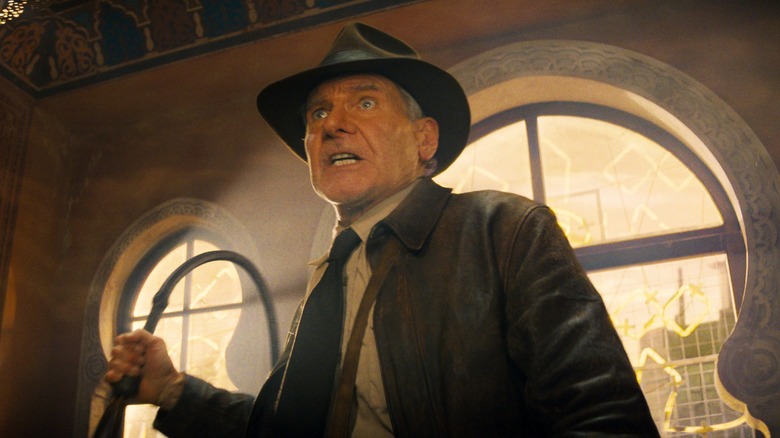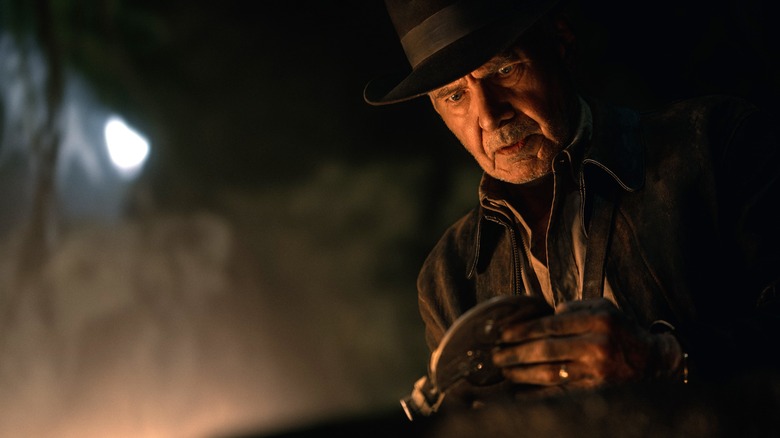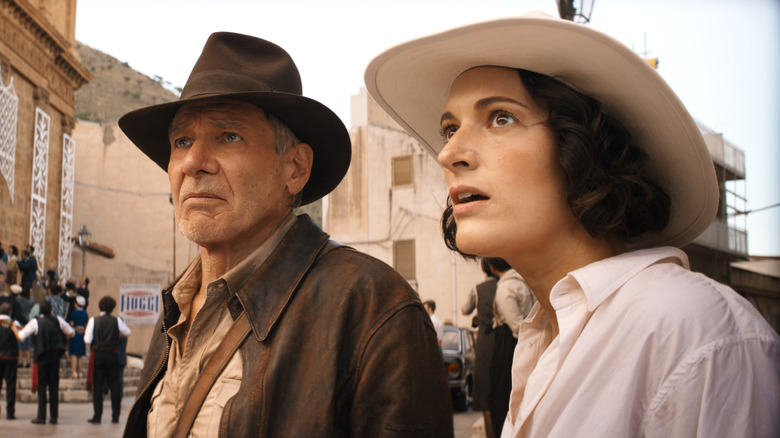Indiana Jones 5 Director Explains How The Film's Action Defines Indy & More
If there's one thing that has consistently rocked the worlds of "Indiana Jones" movie fans over the decades, it's been the action that's escalated the adventures Harrison Ford's titular figure has embarked on. From the time a massive, rounded boulder came close to mowing down Indy to kick off 1981's "Raiders of the Lost Ark" — and all of the exhilarating moments in the films thereafter — fans have come to expect being bowled over in every single adventure in the saga.
Of course, the filmmakers responsible for creating the timeless thrills in the first four Indy chapters are Steven Spielberg and George Lucas, who, for the fifth and final adventure in the saga, "Indiana Jones and the Dial Of Destiny," have handed off the reins to director James Mangold. Yet while Mangold is clearly talented in weaving expertly crafted action scenes into such films as "3:10 to Yuma," "Logan," and "Ford vs. Ferrari," he never wants the action to overpower the story or characters driving it, especially in directing an "Indiana Jones" film.
"I think that the really tricky thing to somehow communicate is that every set piece and kind of sequence in a movie like this is, [is that it's] an incredibly complex tapestry of things [including] your number of shots, stunts, [and] dramatic scenes," Mangold told Rotten Tomatoes. "But what you're also trying to do in an 'Indiana Jones' film versus a kind of more conventional action picture is [remembering] that character is such an important part of these movies."
Mangold says Indiana Jones is about fulfillment of character
"Indiana Jones and the Dial of Destiny" begins with an elaborate 20-minute action sequence, where — thanks to de-aging technology and decades-old footage of the actor that fans never got to see — Harrison Ford's Indy is featured in scenes set in the 1940s during World War II. Along with his fellow archaeologist, Basil Shaw (Toby Jones), Indy attempts to secure Archimedes' Antikythera, aka "The Dial of Destiny," which, according to legend, provides the ability to open time portals to the past.
From there, the story leaps forward to 1969, where Indy is recruited to go on one last big adventure by Basil's daughter, Helena Shaw (Phoebe Waller-Bridge), to locate the second half of the dial to make the mechanism fully functional. And while their pursuit of the dial is loaded with the sort of action sequences that have come to define the "Indiana Jones" saga, James Mangold said he was intent on making the story behind the pursuit just as important as the pursuit itself.
"I like to think that my personal kind of philosophy is just, if you're making a musical, [in] the best musicals it's not like the story stops and they sing, and then the story moves on. [You find] that through singing, there are more connections made," Mangold told Rotten Tomatoes. "Similarly, in a kind of action movie — particularly with what Stephen and Harrison and George developed in the first [Indy movies], the action is a fulfillment of character, not just the most greatest and latest display of stunts and visual effects."
Indy and Helena's produces 'frantic and wonderful energy,' Mangold says
Using the pivotal Morocco action sequence in "Indiana Jones and the Dial of Destiny" as an example, James Mangold explained how he struck the balance between the film's characters and obstacles they encounter. "[In addition to the action], the entire sequence also becomes an ongoing argument between Harrison and Phoebe's characters, Indy and Helena ... We're still sorting character stuff while they are almost getting impaled and shot, and run over," Mangold said in his Rotten Tomatoes interview. "It's this commingling and kind of tiling of all this stuff on top of each other that produces some of the really frantic and wonderful energy that I think is the hallmark of these pictures."
While "Indiana Jones and the Dial of Destiny" has its fine share of action scenes, Mangold also left room for some quieter, more intimate moments, including Indy's bittersweet retirement from his long tenure as a university archaeology professor.
Asked by Entertainment Weekly how he would bid farewell to fans of the movie saga, Harrison Ford imagined his retirement speech to "Indiana Jones" fans by responding, "Thanks for putting up with me. I hope you've had a good time ... I sure have."


